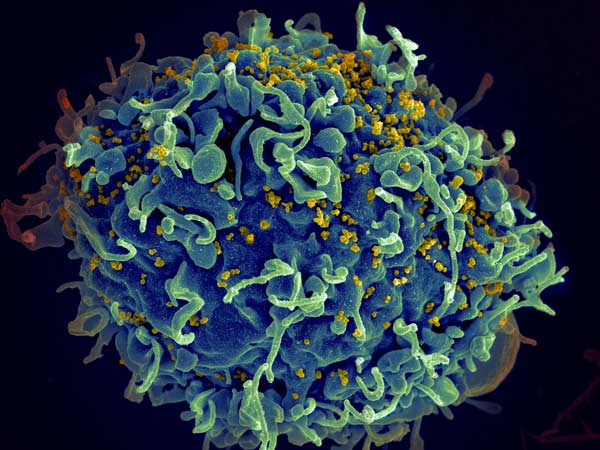HIV replicates in brain, CNS shortly after infection
HIV may begin replicating within a patient’s brain and central nervous system as soon as 4 months after infection, according to data recently published in PLoS Pathogens.
“While HIV-1 can be detected in both the cerebrospinal fluid (CSF) and brain tissue during the weeks after initial exposure,” the researchers wrote, “it is unknown when the virus actually begins replicating independently in the central nervous system (CNS).”
To explore early replication within the CNS, researchers examined HIV-1 RNA concentrations in paired blood plasma and CSF samples from 72 adult participants for a 2-year period. All but one of the participants had not initiated ART, and 37 provided additional samples during follow-up assessments. Single genome amplification and phylogenetic analysis were used to determine viral populations in addition to the presence of cellular inflammation.

Figure 1. This photo shows HIV (yellow) infecting a human immune cell.
Source:Seth Pincus, Elizabeth Fischer and Austin Athman
“Independent viral replication within the CNS has two important implications,” the researchers wrote. “First, HIV-1 replication can lead to CNS dysfunction and injury. Second, independent CNS replication may also provide a reservoir distinct from that found in CD4+ T cells in the blood and lymphoid tissue.”
Independent replication within the CNS was detected in 7% of samples 4 months after infection or longer. Of those included in longitudinal sampling, 30% showed signs of CNS viral replication or inflammation in at least one examination, and 16% showed signs at multiple points.
Using these observations, the researchers also suggested four separate stages of early infection characterized by the relationship between HIV in the blood and in the CNS. This model, the researchers wrote, implies distinct interaction mechanisms between the virus and the host.
“These results underscore the importance of early diagnosis and treatment with antiretroviral therapy,” Dianne Rausch, PhD, director of the Division of AIDS Research within the NIH’s National Institute of Mental Health, said in a press release. “Any delay runs the risk that the virus could find refuge and cause damage in the brain, where some medications are less effective — potentially enabling it to re-emerge, even after it is suppressed in the periphery.”
Disclosure: The researchers report no relevant financial disclosures.
